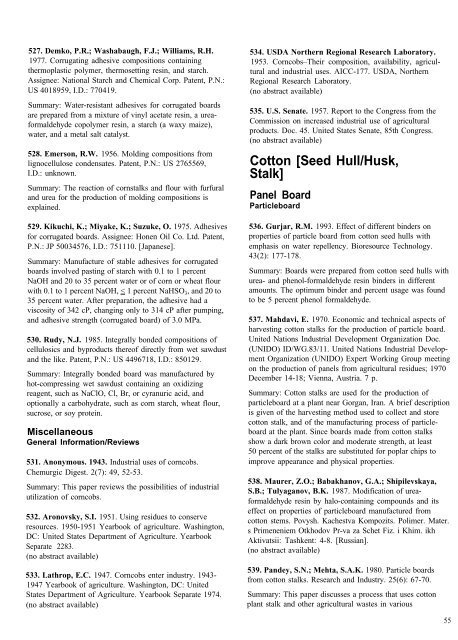Literature Review on Use of Nonwood Plant Fibers for Building ...
Literature Review on Use of Nonwood Plant Fibers for Building ...
Literature Review on Use of Nonwood Plant Fibers for Building ...
You also want an ePaper? Increase the reach of your titles
YUMPU automatically turns print PDFs into web optimized ePapers that Google loves.
527. Demko, P.R.; Washabaugh, F.J.; Williams, R.H.<br />
1977. Corrugating adhesive compositi<strong>on</strong>s c<strong>on</strong>taining<br />
thermoplastic polymer, thermosetting resin, and starch.<br />
Assignee: Nati<strong>on</strong>al Starch and Chemical Corp. Patent, P.N.:<br />
US 4018959, I.D.: 770419.<br />
Summary: Water-resistant adhesives <strong>for</strong> corrugated boards<br />
are prepared from a mixture <strong>of</strong> vinyl acetate resin, a urea<strong>for</strong>maldehyde<br />
copolymer resin, a starch (a waxy maize),<br />
water, and a metal salt catalyst.<br />
528. Emers<strong>on</strong>, R.W. 1956. Molding compositi<strong>on</strong>s from<br />
lignocellulose c<strong>on</strong>densates. Patent, P.N.: US 2765569,<br />
I.D.: unknown.<br />
Summary: The reacti<strong>on</strong> <strong>of</strong> cornstalks and flour with furfural<br />
and urea <strong>for</strong> the producti<strong>on</strong> <strong>of</strong> molding compositi<strong>on</strong>s is<br />
explained.<br />
529. Kikuchi, K.; Miyake, K.; Suzuke, O. 1975. Adhesives<br />
<strong>for</strong> corrugated boards. Assignee: H<strong>on</strong>en Oil Co. Ltd. Patent,<br />
P.N.: JP 50034576, I.D.: 751110. [Japanese].<br />
Summary: Manufacture <strong>of</strong> stable adhesives <strong>for</strong> corrugated<br />
boards involved pasting <strong>of</strong> starch with 0.1 to 1 percent<br />
NaOH and 20 to 35 percent water or <strong>of</strong> corn or wheat flour<br />
with 0.1 to 1 percent NaOH, < 1 percent NaHSO 3, and 20 to<br />
35 percent water. After preparati<strong>on</strong>, the adhesive had a<br />
viscosity <strong>of</strong> 342 cP, changing <strong>on</strong>ly to 314 cP after pumping,<br />
and adhesive strength (corrugated board) <strong>of</strong> 3.0 MPa.<br />
530. Rudy, N.J. 1985. Integrally b<strong>on</strong>ded compositi<strong>on</strong>s <strong>of</strong><br />
cellulosics and byproducts there<strong>of</strong> directly from wet sawdust<br />
and the like. Patent, P.N.: US 4496718, I.D.: 850129.<br />
Summary: Integrally b<strong>on</strong>ded board was manufactured by<br />
hot-compressing wet sawdust c<strong>on</strong>taining an oxidizing<br />
reagent, such as NaClO, Cl, Br, or cyranuric acid, and<br />
opti<strong>on</strong>ally a carbohydrate, such as corn starch, wheat flour,<br />
sucrose, or soy protein.<br />
Miscellaneous<br />
General In<strong>for</strong>mati<strong>on</strong>/<str<strong>on</strong>g>Review</str<strong>on</strong>g>s<br />
531. An<strong>on</strong>ymous. 1943. Industrial uses <strong>of</strong> corncobs.<br />
Chemurgic Digest. 2(7): 49, 52-53.<br />
Summary: This paper reviews the possibilities <strong>of</strong> industrial<br />
utilizati<strong>on</strong> <strong>of</strong> corncobs.<br />
532. Ar<strong>on</strong>ovsky, S.I. 1951. Using residues to c<strong>on</strong>serve<br />
resources. 1950-1951 Yearbook <strong>of</strong> agriculture. Washingt<strong>on</strong>,<br />
DC: United States Department <strong>of</strong> Agriculture. Yearbook<br />
Separate 2283.<br />
(no abstract available)<br />
533. Lathrop, E.C. 1947. Corncobs enter industry. 1943-<br />
1947 Yearbook <strong>of</strong> agriculture. Washingt<strong>on</strong>, DC: United<br />
States Department <strong>of</strong> Agriculture. Yearbook Separate 1974.<br />
(no abstract available)<br />
534. USDA Northern Regi<strong>on</strong>al Research Laboratory.<br />
1953. Corncobs–Their compositi<strong>on</strong>, availability, agricultural<br />
and industrial uses. AICC-177. USDA, Northern<br />
Regi<strong>on</strong>al Research Laboratory.<br />
(no abstract available)<br />
535. U.S. Senate. 1957. Report to the C<strong>on</strong>gress from the<br />
Commissi<strong>on</strong> <strong>on</strong> increased industrial use <strong>of</strong> agricultural<br />
products. Doc. 45. United States Senate, 85th C<strong>on</strong>gress.<br />
(no abstract available)<br />
Cott<strong>on</strong> [Seed Hull/Husk,<br />
Stalk]<br />
Panel Board<br />
Particleboard<br />
536. Gurjar, R.M. 1993. Effect <strong>of</strong> different binders <strong>on</strong><br />
properties <strong>of</strong> particle board from cott<strong>on</strong> seed hulls with<br />
emphasis <strong>on</strong> water repellency. Bioresource Technology.<br />
43(2): 177-178.<br />
Summary: Boards were prepared from cott<strong>on</strong> seed hulls with<br />
urea- and phenol-<strong>for</strong>maldehyde resin binders in different<br />
amounts. The optimum binder and percent usage was found<br />
to be 5 percent phenol <strong>for</strong>maldehyde.<br />
537. Mahdavi, E. 1970. Ec<strong>on</strong>omic and technical aspects <strong>of</strong><br />
harvesting cott<strong>on</strong> stalks <strong>for</strong> the producti<strong>on</strong> <strong>of</strong> particle board.<br />
United Nati<strong>on</strong>s Industrial Development Organizati<strong>on</strong> Doc.<br />
(UNIDO) ID/WG.83/11. United Nati<strong>on</strong>s Industrial Development<br />
Organizati<strong>on</strong> (UNIDO) Expert Working Group meeting<br />
<strong>on</strong> the producti<strong>on</strong> <strong>of</strong> panels from agricultural residues; 1970<br />
December 14-18; Vienna, Austria. 7 p.<br />
Summary: Cott<strong>on</strong> stalks are used <strong>for</strong> the producti<strong>on</strong> <strong>of</strong><br />
particleboard at a plant near Gorgan, Iran. A brief descripti<strong>on</strong><br />
is given <strong>of</strong> the harvesting method used to collect and store<br />
cott<strong>on</strong> stalk, and <strong>of</strong> the manufacturing process <strong>of</strong> particleboard<br />
at the plant. Since boards made from cott<strong>on</strong> stalks<br />
show a dark brown color and moderate strength, at least<br />
50 percent <strong>of</strong> the stalks are substituted <strong>for</strong> poplar chips to<br />
improve appearance and physical properties.<br />
538. Maurer, Z.O.; Babakhanov, G.A.; Shipilevskaya,<br />
S.B.; Tulyaganov, B.K. 1987. Modificati<strong>on</strong> <strong>of</strong> urea<strong>for</strong>maldehyde<br />
resin by halo-c<strong>on</strong>taining compounds and its<br />
effect <strong>on</strong> properties <strong>of</strong> particleboard manufactured from<br />
cott<strong>on</strong> stems. Povysh. Kachestva Kompozits. Polimer. Mater.<br />
s Primeneniem Otkhodov Pr-va za Schet Fiz. i Khim. ikh<br />
Aktivatsii: Tashkent: 4-8. [Russian].<br />
(no abstract available)<br />
539. Pandey, S.N.; Mehta, S.A.K. 1980. Particle boards<br />
from cott<strong>on</strong> stalks. Research and Industry. 25(6): 67-70.<br />
Summary: This paper discusses a process that uses cott<strong>on</strong><br />
plant stalk and other agricultural wastes in various<br />
55

















